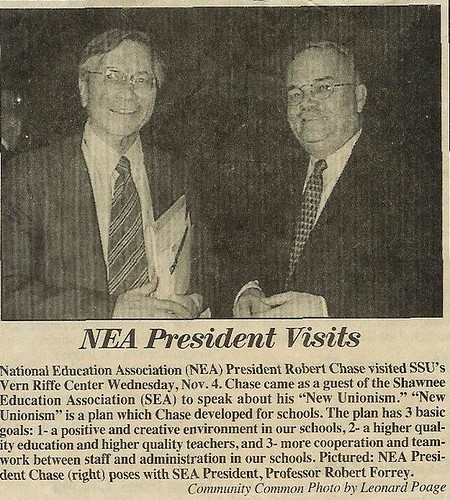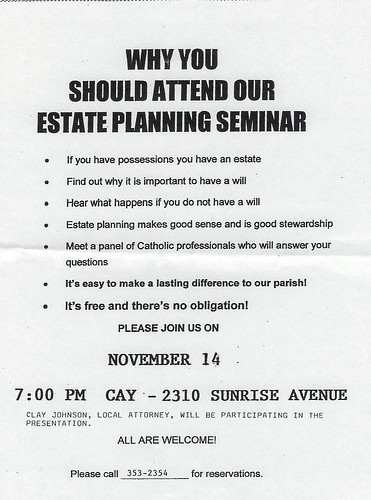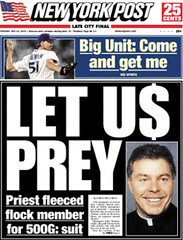
Interest-Based Bargaining
Interest-based bargaining, or IBB, as an online site explains, “is an attempt to move labor and management from traditional confrontational and positional bargaining to problem solving bargaining by identifying issues and exploring the different possible solutions. The parties are encouraged to work together to find solutions to each other’s problems. They do not come to the bargaining table with proposals as in traditional bargaining. Instead, they present problems to be solved. Together they will seek solutions to those problems.”
Back in 1999 at Shawnee State University, when I was serving the first of four terms as president of the Shawnee Education Association (SEA), the faculty union, I and the other union officers, in spite of some misgivings, suggested to the administration that we use Interest-based bargaining for the 2000 round of contract negotiations. We borrowed the idea of using IBB from Bob Chase, the president of the powerful teacher’s union, the National Education Association (NEA), of which SEA was an Ohio affiliate. Interest-based bargaining was one of the elements in Chase’s innovative “New Unionism.” “After much soul-searching and self-criticism within NEA,” Chase had said in a speech in Washington, “we know it’s time to create a new union – an association with an entirely new approach to our members, to our critics, and to our colleagues on the other side of the bargaining table.”
SEA proposing to use IBB in contract negotiations at Shawnee State was like Geronimo proposing to General Custer that they bury the hatchet. In the past, the relations between the faculty and administration at SSU had been terrible, and we thought IBB might offer both sides the chance to improve the notoriously acrimonious relationship. The SEA leadership dared to hope it was possible to change because SSU had a popular new president, James P. Chapman, who publicly endorsed SEA’s Interest-based bargaining proposal. I would not have supported IBB if Chapman had not been president, but I trusted and respected him as a person of integrity, and so did many other faculty. Chapman’s predecessor, Clive Veri, had only a 5% approval rating in his last years in office. For Chapman, it would have been something like 95%
NEA's Chase at SSU
To help adjust the campus community to the idea of IBB, SEA hosted a banquet at the Riffe Center at which NEA president Chase was the featured speaker. In his address, Chase urged the SEA and the SSU administration to work with instead of against each other. He pointed out, “You do have a new president of both the university and the union who are willing to move in some different directions, to look at some different approaches.”

The trustees agreed, with some reluctance, to try IBB in the negotiations for the 2000-2003 contract, and the results were encouraging. For the first time in the university’s fifteen-year history, the word strike was not uttered once during negotiations. I later published “The ‘New Unionism’ Replaces the Old at Shawnee State,” in Thought & Action, the National Educational Association journal for higher education. I concluded that article by saying that the chances of the New Unionism taking hold at Shawnee State were at best about fifty-fifty, but I added that if the New Unionism could work at Shawnee State, “it could work anywhere.”
Undermining New Unionism
Those negotiations were a success, but the New Unionism, and the spirit of cooperation it represented, did not take hold at SSU, largely because some influential and unprincipled trustees, known as the “gang of four,” never intended that it would. These four trustees proved to be totally untrustworthy. What they did was take advantage of the campus thaw brought about by the New Unionism to allow President Chapman and the faculty to resolve several major chronic problems at the university, especially the problem of governance, which the North Central Association had cited as a reason for withholding full accreditation from SSU. President Chapman, working harmoniously with the SEA and other campus constituencies, was able to resolve the governance problem, and a number of other serious problems as well. His performance as president was remarkable, but because he was not the kind of rubber-stamp supine president that the trustees had become accustomed to during the nine-year tenure of Chapman’s incompetent predecessor, the gang of four had resolved that after Chapman had solved several of SSU’s most serious problems, he would not be rehired when his three-year contract expired.
The trustees had hired a lawyer in 1993 to be the de facto president during President Veri’s reign of error, and it was that lawyer, Stephen P. Donohue, not Chapman, whom the gang of four were rumored to want to be the next president. The gang of four preferred that SSU continue to be ranked as one of the worst universities in the nation rather than that they lost their control over and exploitation of it. In order for a former trustee and Republican committee woman to be able to unload her empty Franklin Blvd. house off on the university, which would take a $50,000 loss on it; in order for the chairman of the trustees, Frank Waller, with two partners, to start a fly-by-night travel agency that would become SSU’s preferred travel agency; in order for a failed president reportedly facing serious legal charges to resign and receive a golden parachute as a parting gift; in order for these kinds of shenanigans to continue, it was necessary to remove anybody with scruples and backbone from SSU’s administration. Because Chapman represented an honest and effective style of leadership, he was about as welcome to the gang of four and the over-privileged of Portsmouth as Eliot Ness had been to Chicago racketeers during Prohibition. In some ways, Bob Mollette is now in a similar embattled position on the City Council, and the over-privileged of Portsmouth will not rest until he is removed.
Karla “Kay” Boynton Reynolds showed what the gang of four was plotting even as the Interest-based bargaining negotiations were successfully getting started. On 7 June 2000, she sent a letter to SSU trustee chairman George Clayton. It was Clayton’s empty Kenrick's department store that was taken off his hands in a typical Portsmouth boondoggle, pork-fed real estate deal. “I realize we are in the mist [sic] of union negotiations,” Reynolds wrote, “and should present a united front. I firmly believe the leadership of SSU is the MOST important issue that we as trustees are handling. We should not let the negotiations overshadow our responsibilities.” What were those responsibilities? What was MOST important? To get rid of Chapman when the IBB negotiations were completed and provide new leadership, by which she meant another toady president like Veri, a president who would toe the line and allow the university lawyer to carry out the wishes of those non-educators who were in control of the university. If that president turned out to be incompetent, sleazy, and wildly unpopular, a president who had only semesters, football, and fraternities to offer a university in crisis, then that was a price they were willing to pay to maintain control over SSU. The university was treated as yet another of the pork projects on which the over-privileged of Portsmouth had come to depend economically since the city’s industrial and commercial base had begun migrating overseas a half century earlier.
The incredulous campus exploded when Chapman was not rehired, because during the relatively brief era of New Unionism he had worked miracles at SSU, and had given the faculty hope that we would no longer remain a dysfunctional institution at very bottom of the US News annual rankings of colleges. In three years, he had built up capital that the university has been living on – and frittering away – ever since.
In 2003, after Chapman’s departure, when I was again serving as SEA president, the administration suggested that we repeat the use of Interest-based bargaining to negotiate the 2003-2006 contract.
 The trustees may have concluded that the faculty was no longer as militant as it had been in the pre-IBB days. As a result of a presidential search committee’s unusual spunkiness, we had a new SSU president who gave us reason to be thankful simply because she was not Stephen P. Donohue or Michael Field, the presidential preferences of the gang of four. We did what we could to support Rita Rice Morris, including agreeing to use IBB again. We agreed to it, but we were wary, and wisely so. Mutual trust was lacking, and when we concluded that the leopard had still not lost its spots, nor the scorpion its sting, the mood turned ugly on campus once more, as it almost always had in negotiations in the past. The 2003-2006 contract was settled only after the SEA formed a Crisis Committee, which began to lay the groundwork for a strike, and only after SEA members authorized the negotiating team to conduct a strike vote. Whatever gains we made in the 2003-2006 contract we owed not so much to IBB as to the SEA’s traditional militancy. I have a shirt as a reminder of that militancy.
The trustees may have concluded that the faculty was no longer as militant as it had been in the pre-IBB days. As a result of a presidential search committee’s unusual spunkiness, we had a new SSU president who gave us reason to be thankful simply because she was not Stephen P. Donohue or Michael Field, the presidential preferences of the gang of four. We did what we could to support Rita Rice Morris, including agreeing to use IBB again. We agreed to it, but we were wary, and wisely so. Mutual trust was lacking, and when we concluded that the leopard had still not lost its spots, nor the scorpion its sting, the mood turned ugly on campus once more, as it almost always had in negotiations in the past. The 2003-2006 contract was settled only after the SEA formed a Crisis Committee, which began to lay the groundwork for a strike, and only after SEA members authorized the negotiating team to conduct a strike vote. Whatever gains we made in the 2003-2006 contract we owed not so much to IBB as to the SEA’s traditional militancy. I have a shirt as a reminder of that militancy.In recent SEA elections, the presidency and vice presidency were won by candidates whom faculty believed would be the strongest leaders in the contract negotiations that will begin in the new year. Whether IBB will be attempted again is up to a new generation of SEA leaders. Four past SEA presidents, including myself, retired this year, and a fifth will soon. A younger generation may find a way to end the dysfunctional state of affairs that has plagued Shawnee State in its 20 years as a university. Maybe something like IBB will eventually help end that cycle. But now that I am aware of the larger political context in which the university exists, I can appreciate the wisdom of something Professor Larry Essman, a Portsmouth native and a past SEA president told me some time ago, which is that you cannot understand SSU unless you also understand the politics of Portsmouth. In the last few years I’ve come to learn something about Portsmouth’s politics, and I believe the problems at SSU, because they a part of the political corruption of Portsmouth, are more intractable than most faculty have any idea.
I found it hard to believe that some of the trustees were unable to see what an extraordinary opportunity the New Unionism represented for SSU back in 2000. Only now that I better understand the pork politics of Portsmouth can I begin to understand why the gang of four did what they did. A steady diet of pork for over a half-century has resulted in a glaring loss of initiative, honesty, and competence among the over-privileged of our river city. Elsewhere in America, we hope, people are still competing; in Portsmouth they are colluding. Elsewhere in America, people are working to solve problems; in Portsmouth the over-privileged are covering them up. And they apparently cannot help themselves.
The circumstances surrounding the 2000 Interest-based-bargaining negotiations, and the current trustee chairwoman's untrustworthy role in them, reminds me of the fable in which a scorpion pleads with the wary frog to carry him on his back across a river. Knowing what scorpions are notorious for, the frog refuses, but the scorpion persists, pointing out that if he stung the frog, he too would drown. Persuaded by the scorpion's argument, the frog reluctantly agrees. Halfway across the river, the scorpion fatally stings the frog. The dying frog incredulously asks the scorpion, “Why? Why?” The scorpion, who will soon die himself, answers, “Because I could not help myself. It’s my nature.”







